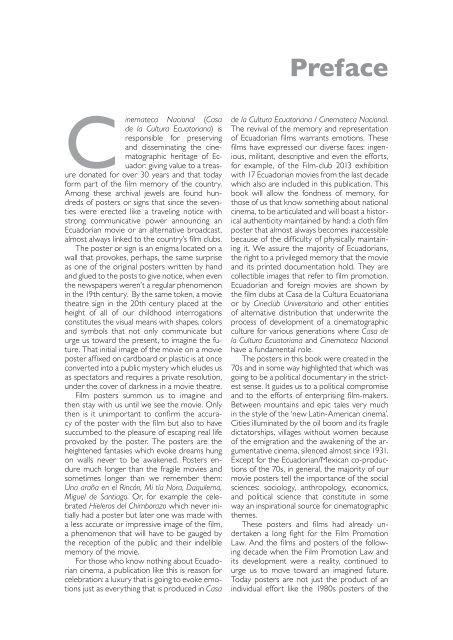Michael Dillon
afichesdecineecuatorianomc00
afichesdecineecuatorianomc00
- No tags were found...
Create successful ePaper yourself
Turn your PDF publications into a flip-book with our unique Google optimized e-Paper software.
PrefaceCinemateca Nacional (Casade la Cultura Ecuatoriana) isresponsible for preservingand disseminating the cinematographicheritage of Ecuador:giving value to a treasuredonated for over 30 years and that todayform part of the film memory of the country.Among these archival jewels are found hundredsof posters or signs that since the seventieswere erected like a traveling notice withstrong communicative power announcing anEcuadorian movie or an alternative broadcast,almost always linked to the country’s film clubs.The poster or sign is an enigma located on awall that provokes, perhaps, the same surpriseas one of the original posters written by handand glued to the posts to give notice, when eventhe newspapers weren’t a regular phenomenonin the 19th century. By the same token, a movietheatre sign in the 20th century placed at theheight of all of our childhood interrogationsconstitutes the visual means with shapes, colorsand symbols that not only communicate buturge us toward the present, to imagine the future.That initial image of the movie on a movieposter affixed on cardboard or plastic is at onceconverted into a public mystery which eludes usas spectators and requires a private resolution,under the cover of darkness in a movie theatre.Film posters summon us to imagine andthen stay with us until we see the movie. Onlythen is it unimportant to confirm the accuracyof the poster with the film but also to havesuccumbed to the pleasure of escaping real lifeprovoked by the poster. The posters are theheightened fantasies which evoke dreams hungon walls never to be awakened. Posters enduremuch longer than the fragile movies andsometimes longer than we remember them:Una araña en el Rincón, Mi tía Nora, Daquilema,Miguel de Santiago. Or, for example the celebratedHieleros del Chimborazo which never initiallyhad a poster but later one was made witha less accurate or impressive image of the film,a phenomenon that will have to be gauged bythe reception of the public and their indeliblememory of the movie.For those who know nothing about Ecuadoriancinema, a publication like this is reason forcelebration: a luxury that is going to evoke emotionsjust as everything that is produced in Casade la Cultura Ecuatoriana / Cinemateca Nacional.The revival of the memory and representationof Ecuadorian films warrants emotions. Thesefilms have expressed our diverse faces: ingenious,militant, descriptive and even the efforts,for example, of the Film-club 2013 exhibitionwith 17 Ecuadorian movies from the last decadewhich also are included in this publication. Thisbook will allow the fondness of memory, forthose of us that know something about nationalcinema, to be articulated and will boast a historicalauthenticity maintained by hand: a cloth filmposter that almost always becomes inaccessiblebecause of the difficulty of physically maintainingit. We assure the majority of Ecuadorians,the right to a privileged memory that the movieand its printed documentation hold. They arecollectible images that refer to film promotion.Ecuadorian and foreign movies are shown bythe film clubs at Casa de la Cultura Ecuatorianaor by Cineclub Universitario and other entitiesof alternative distribution that underwrite theprocess of development of a cinematographicculture for various generations where Casa dela Cultura Ecuatoriana and Cinemateca Nacionalhave a fundamental role.The posters in this book were created in the70s and in some way highlighted that which wasgoing to be a political documentary in the strictestsense. It guides us to a political compromiseand to the efforts of enterprising film-makers.Between mountains and epic tales very muchin the style of the ‘new Latin-American cinema’.Cities illuminated by the oil boom and its fragiledictatorships, villages without women becauseof the emigration and the awakening of the argumentativecinema, silenced almost since 1931.Except for the Ecuadorian/Mexican co-productionsof the 70s, in general, the majority of ourmovie posters tell the importance of the socialsciences: sociology, anthropology, economics,and political science that constitute in someway an inspirational source for cinematographicthemes.These posters and films had already undertakena long fight for the Film PromotionLaw. And the films and posters of the followingdecade when the Film Promotion Law andits development were a reality, continued tourge us to move toward an imagined future.Today posters are not just the product of anindividual effort like the 1980s posters of the


